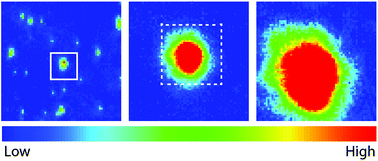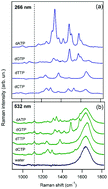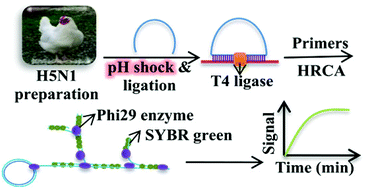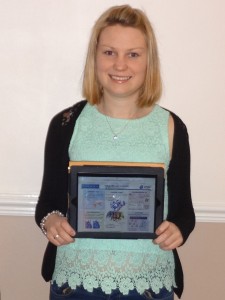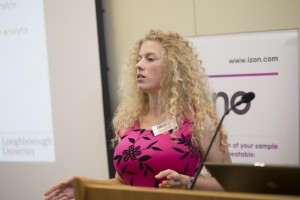Take a look at our most recent HOT Analyst articles, these are now free to access for the next few weeks!
Rapid biodiagnostic ex vivo imaging at 1 μm pixel resolution with thermal source FTIR FPA
C. R. Findlay, R. Wiens, M. Rak, J. Sedlmair, C. J. Hirschmugl, Jason Morrison, C. J. Mundy, M. Kansiz and K. M. Gough
Analyst, 2015, 140, 2493-2503
DOI: 10.1039/C4AN01982B
Controlled growth of immunogold for amplified optical detection of aflatoxin B1
Xu Wang, Reinhard Niessner and Dietmar Knopp
Analyst, 2015, 140, 1453-1458
DOI: 10.1039/C4AN02281E
A Comparative Study of Graphene-Hydrogel Hybrid Bionanocomposites for Biosensing
S. L. Burrs, D. C. Vanegas, M. Bhargava, N. Mechulan, P. Hendershot, H. Yamaguchi, C. Gomes and E. S. McLamore
Analyst, 2015, 140, 1466-1476
DOI: 10.1039/C4AN01788A
Pre-Equlibration Kinetic Size-Exclusion Chromatography with Mass Spectrometry Detection (peKSEC-MS) for Label-Free Solution-Based
Jiayin Bao, Svetlana M. Krylova, Leonid T. Cherney, J. C. Yves Le Blanc, Patrick Pribil, Philip E. Johnson, Derek J. Wilson and Sergey N. Krylov
Analyst, 2015, 140, 990-994
DOI: 10.1039/C4AN02232G
Forensic determination of blood sample age using a bioaffinity-based assay
Juliana Agudelo, Crystal Huynh and Jan Halámek
Analyst, 2015, 140, 1411-1415
DOI: 10.1039/C4AN02269F
Oxidative damage in DNA bases revealed by UV Resonant Raman spectroscopy
Francesco D’Amico, Francesca Cammisuli, Riccardo Addobbati, Clara Rizzardi, Alessandro Gessini, Claudio Masciovecchio, Barbara Rossi and Lorella Pascolo
Analyst, 2015, 140, 1477-1485
DOI: 10.1039/C4AN02364A
The lipid-reactive oxygen species phenotype of breast cancer. Raman spectroscopy and mapping, PCA and PLSDA for invasive ductal carcinoma and invasive lobular carcinoma. Molecular tumorigenic mechanis
Jakub Surmacki, Beata Brozek-Pluska, Radzislaw Kordek and Halina Abramczyk
Analyst, 2015, 140, 2121-2133
DOI: 10.1039/C4AN01876A
Self-cleaning properties in engineered sensors for dopamine electroanalytical detection
Guido Soliveri, Valentina Pifferi, Guido Panzarasa, Silvia Ardizzone, Giuseppe Cappelletti, Daniela Meroni, Katia Sparnacci and Luigi Falciola
Analyst, 2015, 140, 1486-1494
DOI: 10.1039/C4AN02219J
Near-infrared excited ultraviolet emitting upconverting phosphors as an internal light source in dry chemistry test strips for glucose sensing
T. Valta, V. Kale, T. Soukka and C. Horn
Analyst, 2015, Advance Article
DOI: 10.1039/C4AN02028F
Micromotors to capture and destroy anthrax simulant spores
Jahir Orozco, Guoqing Pan, Sirilak Sattayasamitsathit, Michael Galarnyk and Joseph Wang
Analyst, 2015, 140, 1421-1427
DOI: 10.1039/C4AN02169J
Compact 3D-Printed Interface for Coupling Open Digital Microchips with Venturi Easy Ambient Sonic-Spray Ionization Mass Spectrometry
Jie-Bi Hu, Ting-Ru Chen, Chia-Hsien Chang, Ji-Yen Cheng, Yu-Chie Chen and Pawel L. Urban
Analyst, 2015, 140, 1495-1501
DOI: 10.1039/C4AN02220C
Rapid Microstructure Characterization of Polymer Thin Films with 2D-Array Multifocus Raman Microspectroscopy
Ashok Zachariah Samuel, Sohshi Yabumoto, Kenichi Kawamura and Koichi Iwata
Analyst, 2015, 140, 1847-1851
DOI: 10.1039/C4AN01983K
Real-time detection of H5N1 influenza virus through hyperbranched rolling circle amplification
Seyed Vahid Hamidi, Hedayatollah Ghourchian and Gholamreza Tavoosidana
Analyst, 2015, 140, 1502-1509
DOI: 10.1039/C4AN01954G
Nitrogen-Doped Carbon Dots from Plant Cytoplasm as Selective and Sensitive Fluorescent Probes for Detecting P-Nitroaniline in Both Aqueous and Soil Systems
Haoran Yuan, Denian Li, Yan Liu, Xizhe Xu and Chuanxi Xiong
Analyst, 2015, 140, 1428-1431
DOI: 10.1039/C4AN01869A
Simultaneous strain and temperature sensing using slightly tapered optical fiber with inner air-cavity
H. F. Chen, D. N. Wang and Y. Wang
Analyst, 2015, 140, 1859-1862
DOI: 10.1039/C4AN02230K


